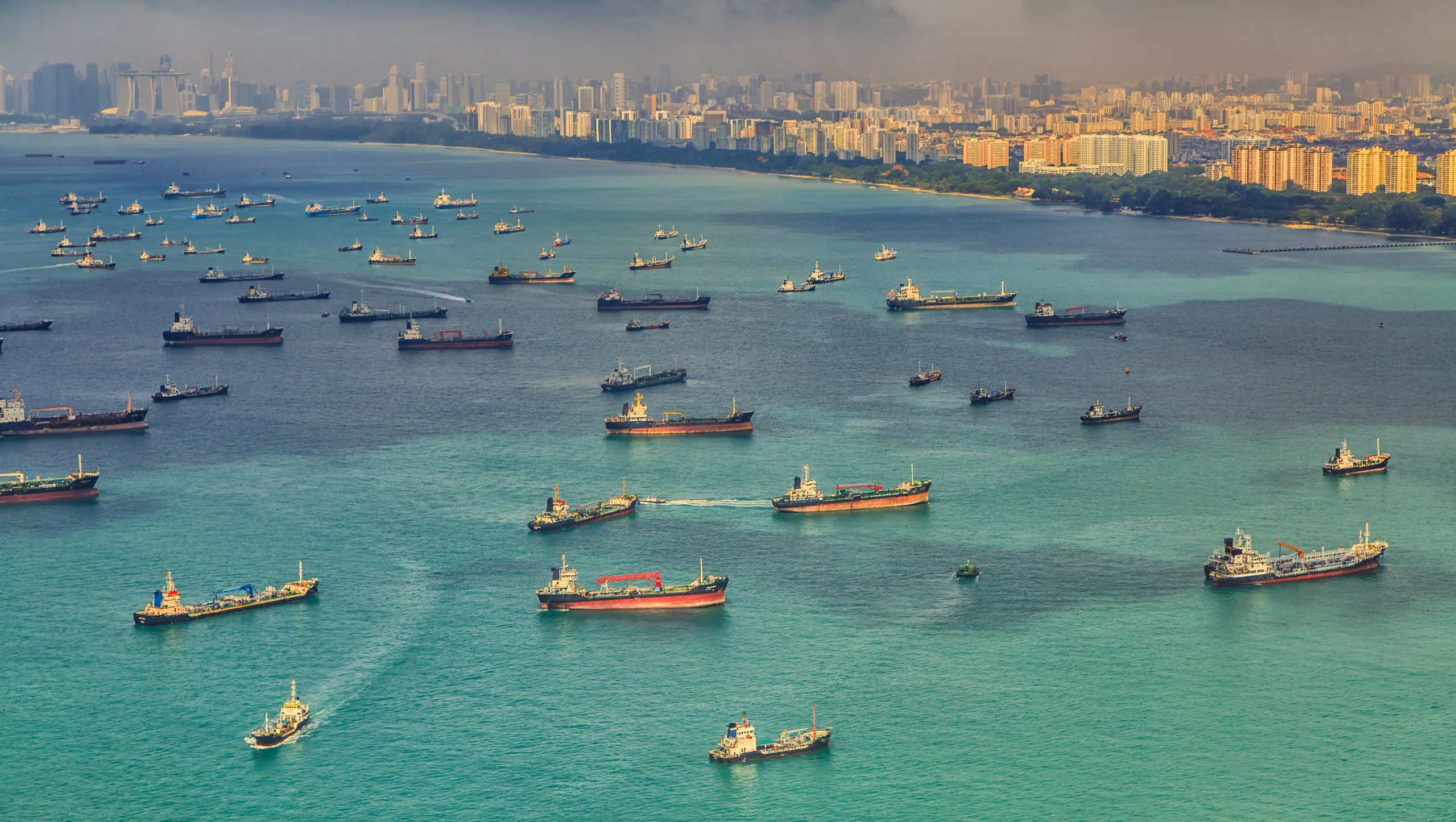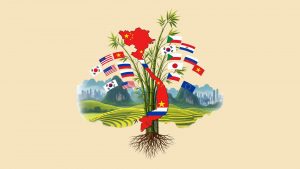It’s no exaggeration to say that much of the global economy hinges on a single 500 mile-long stretch of water. The Straits of Malacca, running between the Bay of Bengal and the South China Sea, with Indonesia on one side and Malaysia on the other, have long been understood to be a chokepoint controlling maritime access to the Far East. They are one of only two western approaches to the South China Sea, and by far the most suitable for shipping – the other, the Sunda Strait, is narrower, shallower, further away, and passes under the shadow of Krakatoa, one of the world’s more active volcanoes. It also points in the wrong direction. While the Straits of Malacca funnel traffic toward Myanmar and the Indian subcontinent, the Sunda Strait opens onto the emptiness of the southern Indian Ocean. From the other side, they are China’s shortest and best sea-route to India, the Middle East, and Africa. With an epic history, and an uncertain future, no one with an interest in contemporary trade and geopolitics can afford to ignore them.
Spices, empire and war: the Straits in history
The great powers have always been drawn to the Straits, and Melaka, the port for which they’re named. The legendary Chinese admiral Zheng He established a base here in the early 1400s, turning it into one of the world’s great trading cities. A century later, it was conquered by the Portuguese, enabling them to dominate the lucrative Indian Ocean spice trade. ‘Whoever is lord of Malacca has his hand on the throat of Venice’, one fidalgo said. The country that could control the flow of spice from the east could call the shots in Europe. The contest was on.
Next to arrive were the Dutch, who seized control of the city and ruled for two centuries. But rather than make the best of the advantages this gave them, the Dutch focused their attentions on Jakarta, near the Sunda Strait, and Melaka sank into decline. The door was wide open for the British to take the lead. But instead of invading Melaka, in a particularly farsighted move the English adventurer Stamford Raffles and his Scottish lieutenant William Farquhar (an Aberdeenshire man) established a fortified trading post on an island at the southern end of the Straits as a replacement. We know it as Singapore.
The city exploded in size, mainly due to Chinese migration, and fast became both a linchpin of the global economy and a centrepiece in British naval strategy. Before the First World War, the British admiral Jackie Fisher called Singapore one of the ‘keys to the world’. Just as the Portuguese had made themselves masters of the eastern trade by seizing Melaka, Britain ruled the waves east of Suez because of Singapore. The pride of the empire in the Far East, Singapore was built into a fortress as well as a thriving port city. But its planners made a fatal error in their designs. Everyone who had conquered the Straits before had come from the sea. The Japanese would not.
It was, Winston Churchill said, ‘the worst disaster and single largest capitulation in British history’. In February 1942, 100,000 British, Australian and Indian troops were captured, and the city lost – to men who had arrived overland, some on bicycles. The Japanese ruled Singapore as the southern capital of their new empire, and for three years the city cowered in fear. Chinese civilians were rounded up and machine-gunned en masse on the beaches. Others were herded onto crude rafts, towed out to sea and cut adrift. Food became scarce everywhere. Allied prisoners of war were forced into the desperately overcrowded Changi jail or sent to work as slaves, building railways and airfields alongside tens of thousands of Malay civilians.
The Japanese surrendered Singapore and Melaka in August 1945, and the British moved to reassert control. But the very idea of empire couldn’t survive after the events of 1942. The Straits Settlements were incorporated into Malaya, which became independent in 1957 after a successful rearguard action against Communist rebels. As Britain dismantled its empire east of Suez, Singapore was briefly incorporated into the new state of Malaysia in 1963. But just two years later it was expelled. Cast adrift with no support, and little economy to speak of – without even a reliable source of water – Singapore should have been doomed. Instead, it became one of the world’s most advanced cities, a testament to the singleminded determination of its people. Meanwhile, Melaka was superseded by Kuala Lumpur, further to the north.
The Straits today – and tomorrow
As fascinating – and bloody – as the history of the Straits is, they still matter today. Spice might have been replaced by oil, gas, grain, containers and data, but the Straits of Malacca still dominate trade. 40% of all globally traded goods pass through these waters. The phone or computer you are reading this on almost certainly did. For some countries and some commodities, the percentage is even higher: 80% of Japan’s oil supply transits the Straits. In the early 2000s the same was true of China, which imports nearly all of its oil and large amounts of its grain, leading former President Hu Jintao to publicly state his concerns about a ‘Malacca dilemma’ in 2003. With the country so dependent on frictionless international trade to grow its economy and supply its basic needs, and international trade so dependent on this narrow stretch of water, haunted by pirates and eyed greedily by armchair strategists across the world, could China afford to remain so vulnerable?
As China doubled down on its investments in Africa and the Middle East in the 2000s and 2010s, the Straits still represented the best, shortest, and most cost-effective route to the west. But it wouldn’t do to depend so much on one potential point of weakness. So instead, in a grand strategy that puts Raffles and Farquhar to shame, China has thrown money at schemes across the world designed to counteract the Malacca dilemma, under the rubric of the Belt and Road programme.
Malacca and megaprojects
Some of these projects are straightforward. A massive deep-water port at Gwadar, on the Pakistani coast, connects to the refurbished highways and railroads of the Trans-Karakoram corridor and gives China a route – admittedly much more expensive per tonnage-mile – to the Indian Ocean that sidesteps Malacca and the South China Sea entirely. A similar project is underway at Kyaukpyu on the Rakhine coast of Myanmar, where another deep-water port would connect to roads leading into Yunnan. Investment into railroads and pipelines connecting the interior with Siberia and Central Asia also falls under this strategy, as does increased interest in the trans-polar route along the northern Russian coast. Each one serves as a potential alternative to Malacca, although none can yet match it for ease of access, existing infrastructure or cost-effectiveness.
Other projects are on a biblical scale. Thailand has previously considered a partnership with China to build what would become a 21st century equivalent to Suez or Panama: a massive, 100km-long canal across the narrow Kra Isthmus that separates the South China Sea from the Indian Ocean, north of the Straits. However, nothing has come to pass, and no agreements have yet been made. Potential investors – from all countries – keep coming away empty-handed. Perhaps this is for the best: the Kra Canal would be one of the most expensive things ever built. (After all, it would require digging across an entire country). The project, while technically possible, would have such significant geopolitical consequences that it can be difficult to imagine what the world would look like after it was done. Whoever built this canal would bypass the Straits of Malacca once and for all, and cut 1200 kilometres off existing trade routes, radically reducing transport costs. The implications are profound. Whatever images we might have of them in Scotland – harmless bits of water for messing about in boats in – canals mean power. British maritime hegemony was the product of control of the Suez Canal; the empire died there. The Panama Canal was so important to US interests that Teddy Roosevelt fomented a rebellion in Panama, until then a quiet province of Colombia, just to seize the corridor where the canal would be dug. The US maintained strict control until 1977. Today, the canal represents the majority of the Panamanian economy, and is the only viable route between the Atlantic and Pacific. (A recent scheme to build a second canal in Nicaragua came to nothing). The Kra Canal would do the same – and nothing would ever be the same. If successful, it might even eclipse Singapore and Malacca forever. But who would control it?
Ports and pirates
As vital as the Straits are to contemporary trade, and as much as they occupy the thoughts of military strategists in China, India, Australia and America, they face a further persistent threat – pirates. The Straits are relatively narrow and shallow, and any ship charting a course along them must run a gauntlet of thousands of small islands, and long, empty coasts of mangrove swamps and hidden creeks – in other words, perfect pirate country.
Pirates have plagued these waters for centuries. Zheng He destroyed a pirate fleet at Palembang, in the southern approaches, in 1407. The Portuguese and Dutch fought them too, while Britain poured in vast resources to quelling the ‘sea robbers’ of Malaya in the nineteenth century. But piracy has never truly gone away – the geography is too favourable, and the pickings too rich. Often the pirates served a valuable political purpose, and were protected by local rulers who found them useful, deniable tools for their aims. The same remains true today. While some pirates are just opportunists looking to make a quick buck, others belong to transnational organised crime networks, or even to secessionist groups. Almost all are now concentrated on the Indonesian side of the Straits, in Sumatra, where the resources of the central government are stretched thin, and Jakarta often struggles to assert itself.
The pirate of today does not have a galleon, peg-leg and parrot; more often than not he is a fisherman by day, and uses the same fast, manoeuvrable skiff for both tasks. Crude scaling ladders can be made quickly from tree trunks and thrown overboard if a naval patrol gets too close. Weapons are readily available if one knows where to look. It only takes a rifle and a bit of misguided determination to make a pirate out of an ordinary fisherman.
Modern piracy in the Straits reached a peak in 2006, when Lloyds of London, the maritime insurers, added a hefty premium to all cargoes routed through Malacca. But despite the elevated risk, no-one could afford to stop using the route: it was too embedded in global supply chains, too important to avoid. A multinational coalition was put together by Indonesia, Malaysia, Thailand and Singapore. Although the Singaporeans had advocated for international involvement, as was being done with remarkable results in Somalia, Malaysia and Indonesia pushed back. Eventually, the Indian Navy was permitted to have a small role guarding the northern approaches to the Straits from a base in the Andaman and Nicobar Islands. The anti-piracy patrols were a success, with attacks dropping to near zero by 2008 and remaining relatively low for the next decade.
However, since 2014 there has been an uptick in piracy in the Straits again, as the analyst Martin Purbrick has recently reported. That year, Time magazine called them ‘the most dangerous waters in the world’. Since the suppression of the Somali pirates, that well be true. The locus of activity has shifted away from the close waters of Malacca to the more open Singapore Straits, where pirates have the opportunity to disappear into Indonesia’s Riau Islands. Highly-organised crews have shown an interest in targeting oil tankers in particular. Some hold crews for ransom, while others seize cash from ship’s safes. A few attempt to siphon off oil – perhaps not realising that much of the oil transported by sea is not yet refined, and essentially useless to them. But other forms of piracy persist. Opportunistic piracy closely tracks economic instability, as fishermen and port workers left without work make ends meet in the most drastic ways possible. The rolling financial crises of the 2020s will inevitably lead to more piracy. Although not yet near the levels of the 2006 crisis, it is a trend moving in the wrong direction, and one that should be on the agenda of anyone with an interest in the region.
Conclusions
The Straits of Malacca and Singapore are a vital artery of the surprisingly fragile network that holds the modern world together, up there with Suez and Panama. There are few alternatives. Gwadar is useful for Pakistan, but to move goods inland to China requires summiting some of the world’s highest mountains. In recent months it has been rocked by the same civil strife that has enveloped the rest of Pakistan. Kyaukpyu is separated from Yunnan by tough, hilly jungle, and an ongoing civil war. If the Kra Canal becomes a reality, the Straits may lose some of their importance – but people have been proposing such a project for centuries now, and no one has yet managed to build it. Until someone does, for the foreseeable future ships will continue to have to thread their way through these contested waters, as they have for centuries. As they do, they may find themselves sailing under the watchful gaze of warships – or in the sights of pirates.
- Sean Patersonhttps://asiascot.com/author/sean-paterson
- Sean Patersonhttps://asiascot.com/author/sean-paterson
- Sean Patersonhttps://asiascot.com/author/sean-paterson
- Sean Patersonhttps://asiascot.com/author/sean-paterson







